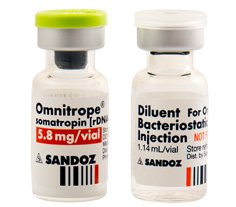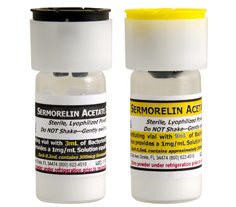HGH Blood Test
 This page is designed to provide everything that anyone needs to know in regards to getting an HGH blood test. It is geared specifically for adults over the age of thirty who feel as though something internal is getting in the way of living life in the best and fullest way possible. This may include low energy and endurance levels, changes to muscle mass and weight that are turning a once toned physique into a flabby mess, hair thinning or loss, sagging skin and wrinkles, joint pains and stiffness, poor sleep, decreased immune system functions, difficulty concentrating, memory concerns, and low libido. Any or all of these signs can point to hormonal imbalance on one or multiple levels. The purpose of this HGH analysis is to diagnose if any of these chemical deficiencies are occurring in order to arrange for the proper treatment. The HGH blood test will allow a doctor who specializes in HRT – hormone replacement therapy – to make the best possible choices in regards to the type or types of medications to prescribe. This will allow for a reversal in the above symptoms, allowing the individual to continue on with his or her life in a revitalized and rejuvenated fashion. Many health conditions, including high cholesterol, diabetes, osteoporosis, obesity, and heart disease will all benefit from this type of treatment. Receiving top notch care from a medical expert in this field will provide the highest level of results.
This page is designed to provide everything that anyone needs to know in regards to getting an HGH blood test. It is geared specifically for adults over the age of thirty who feel as though something internal is getting in the way of living life in the best and fullest way possible. This may include low energy and endurance levels, changes to muscle mass and weight that are turning a once toned physique into a flabby mess, hair thinning or loss, sagging skin and wrinkles, joint pains and stiffness, poor sleep, decreased immune system functions, difficulty concentrating, memory concerns, and low libido. Any or all of these signs can point to hormonal imbalance on one or multiple levels. The purpose of this HGH analysis is to diagnose if any of these chemical deficiencies are occurring in order to arrange for the proper treatment. The HGH blood test will allow a doctor who specializes in HRT – hormone replacement therapy – to make the best possible choices in regards to the type or types of medications to prescribe. This will allow for a reversal in the above symptoms, allowing the individual to continue on with his or her life in a revitalized and rejuvenated fashion. Many health conditions, including high cholesterol, diabetes, osteoporosis, obesity, and heart disease will all benefit from this type of treatment. Receiving top notch care from a medical expert in this field will provide the highest level of results.
Testing Blood for HGH Levels
In order for a doctor to be able to prescribe any type of bioidentical HGH – human growth hormones – testing blood for HGH levels must first be accomplished. The chemicals that are secreted into the system are actually messengers that each play an important role in daily functions. Some control hunger or stress, others have a role in stimulating the production of other vital substances, and some, such as somatotropin (GH – growth hormone) have a wide variety of crucial jobs in the body. This indispensable chemical, secreted by the somatotropin cells in the anterior area of the pituitary gland, is often referred to as the “master hormone” due to its very nature. Not only does it have direct effects on certain bodily functions, it also has indirect roles in part due to how it also stimulates the release of another substance IGF-1 which will be covered in-depth later in this article. Testing blood for HGH levels is crucial to determine if a deficiency is present. This is the only way that the doctor can get a clear scope of vision on the internal situation that is occurring. Unlike other health conditions that are diagnosed with X-rays, MRI’s, or CT Scans, hormone deficiency requires careful blood analysis and the ruling out of other medical problems. Because many of the signs associated with low GH levels can also be indicators of other concerns, it is crucial to provide the doctor with all past and current issues, as well as a complete list of symptoms to ensure that nothing else is taking place that would require specific treatment.Why Do I Need to Do HGH Blood Test?
Why do I need to do HGH blood test instead of just using my symptoms to diagnose this condition? That is an excellent question. There is a wide variety of signs that can be present with low growth hormone production. Most people will have a combination of a number of these when contacting the clinic. Let’s say a woman calls and says that she is noticing hair loss, bald patches, and pitted fingernails that have become brittle and rough like sandpaper. If those are her only symptoms, even though hair loss and brittle nails are signs of GH deficiency, there is a stronger chance that she has a condition called alopecia areata. That is why it is so important to report the changes that are taking place in the body carefully and accurately. The doctor must have a clear picture of the type of testing that needs to take place. Why do I need to do HGH blood test if I have all the symptoms on the list? This may be the most critical reason of all to have adequate analysis performed. In some cases, multiple deficiencies might be present if that many issues have appeared. In cases such as this, the doctor will need to know which hormone levels are low in order to determine which one or ones to treat, and what dosages to prescribe. It is crucial that the right HGH or other medications are ordered in the exact amounts necessary to avoid unwanted side effects and to provide the desired results. This is the only way possible to accomplish that goal.Why the HGH Blood Test is Performed
The reasoning behind why the HGH blood test is performed is this – ensuring the best possible care at all times. Human growth hormone injections cannot be provided without a prescription, and a prescription cannot be provided until GH deficiency has been verified. This requires measuring the levels of various chemicals to ensure an accurate diagnosis. An individual with this condition will more than likely not be very happy with the state of their body at this time. Since the brain’s regions for memory and learning have multiple GH receptors, these areas can become weakened in their functions. Recalling information that has been previously committed to memory can become a tedious task. Anything that is newly learned may not be processed and retained. Focus and clarity can also suffer. Many people report that they lose their drive and ability to concentrate on simple tasks. This is only part of the reason why the HGH blood test is performed. If a person begins to administer this medication into his or her body, and there is no reason for it or the amount is too high, a number of adverse reactions can occur. The body can sense if there is an overload of any particular chemical. In the case of too much HGH growth hormone, the pituitary gland can stop the natural production in order to make up for this overage. That would not be a beneficial occurrence as it is clear that this particular messenger must be kept at an adequate level. There are also a number of negative effects that can occur, including high cholesterol, edema, carpal tunnel syndrome, muscle and joint pains, and an increased risk of developing diabetes.How to Prepare for the HGH Blood Test
The next subject to discuss is how to prepare for the HGH blood test. The good news here is that, unlike many other medical procedures, there are not a lot of things one must do to get ready for visiting the local laboratory. To begin with, during the initial consultation with a hormone replacement specialist, it will be determined where the nearest lab is that will offer convenience for the client. Most of these locations open between 7 and 8 am, allowing for the required early morning testing to be accomplished. Why is it important that the blood be drawn early in the morning? Many different hormones are actually secreted at night while a person is sleeping. Checking these levels first thing in the day before anything else has had a chance to interfere with their production is ideal. The other issue, when asking how to prepare for the HGH blood test, is the fact that this analysis requires an individual to fast from midnight onward of the previous evening. A little water is fine, if needed, but nothing else upon awakening. Food and various beverages can interfere with the necessary results. Once the specimen has been drawn, the client is then able to go and grab their favorite morning beverage and food item with plenty of time to still make it into work before the day officially begins. It is fine to eat as normal the entire day before the test, just remember not to consume anything after midnight.How the Blood Test is Performed
Now it is time to look at how the blood test is performed. The morning of the appointment, the individual will head over to the laboratory where the procedure has been scheduled at the prearranged time. There will usually be a sign-in sheet at the front counter. Write down the name and check the boxes for appointment and labwork. If there is any question as to what to check, simply ask the person behind the counter. There might be a short form to fill out for verification purposes. We will have already sent the required paperwork to the lab so that they will already know what panels to run. Take a seat, and wait for a representative to call you. When taken back into the private room or cubicle, this is where a person will get to see how the blood test is performed. It is advisable not to wear tight sleeves that cannot be rolled up high on the arm. Most technicians prefer to draw the specimen directly from a vein in the inner portion of the elbow. Once the sleeve has been rolled up, the technician will then examine both arms to find the best vein to use. An elastic band will be tied tightly around the upper arm. A gentle palpitation may be done to verify the best vein. Next, an alcohol prep swab will be used to clean the area before the needle is inserted. The client will be directed to make a fist. Once the needle is in place, a tube will be attached inside the syringe to draw out the blood. Multiple tubes may be used depending upon the tests that have been ordered. The elastic band will be released, and the hand can be opened and relaxed. A piece of gauze will be placed on top of the needle, and light pressure will be applied as the needle is withdrawn. The needle will be discarded, and a bandage will be placed over the gauze. This should be left in place for a few hours. It is now time to go eat and proceed with the day.Get Started




















